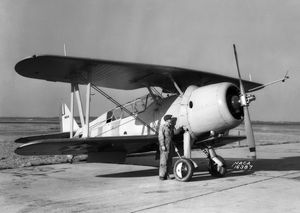avia.wikisort.org - Aeroplane
The Vought XSB3U was an American biplane scout bomber developed by Vought-Sikorsky for the United States Navy during the 1930s. Developed as an alternative to the SB2U Vindicator monoplane, the aircraft proved unsatisfactory to the Navy in comparison, and development was not pursued.
| XSB3U-1 | |
|---|---|
 | |
| Role | Scout bomber |
| Manufacturer | Vought-Sikorsky |
| First flight | 1936 |
| Status | cancelled |
| Primary user | United States Navy |
| Number built | 1 |
| Developed from | SBU Corsair |
| Type | Prototype |
| Serial | 9834[1] |
Design and development
In late 1934, the U.S. Navy's Bureau of Aeronautics (BuAer) issued a specification for new scout bomber and torpedo bomber designs.[2] Eight companies submitted ten designs in response, evenly split between monoplanes and biplanes.[3][N 1]
Exemplifying the Bureau of Aeronautics' reluctance to fully embrace the monoplane configuration for carrier-based aircraft,[4] the XSB3U-1 was proposed as a more conventional alternative to Vought's XSB2U-1, which was designed as a modern monoplane. The XSB3U was modified from the last production SBU Corsair,[3] using essentially the same airframe, including a fully enclosed cockpit, and Pratt & Whitney R-1535 radial engine, but with a more streamlined surface and cowling. In addition, the XSB3U had fully retractable landing gear.[4]
Operational history
The XSB3U-1 was delivered to Naval Air Station Anacostia for evaluation by the U.S. Navy in April 1936;,[5] at the same time as its primary competitor, the XSB2U-1.[4] Comparative testing of the two aircraft during 1936 proved the complete superiority of the monoplane configuration;[6] on the same power, the SB2U-1 was 15 miles per hour (24 km/h) faster despite being larger and heavier than the biplane.[4] However, the Navy was impressed by the XSB3U's method of landing gear retraction, which provided a more streamlined surface after retraction than most other methods used at the time.[7]
Following the end of the evaluation, the XSB3U was retained by the Navy, and used for experimental and liaison purposes by the Navy,[4] also being used by NACA at Langley Field for testing of tail loads starting in August 1938, continuing through January 1939[8] when the aircraft was returned to the Navy, being retired shortly thereafter.[9][10]
Operators
 United States
United States
- United States Navy
- NACA
Specifications (XSB3U-1)
Data from [4]
General characteristics
- Crew: 2 (pilot and observer)
- Length: 28 ft 2 in (8.59 m)
- Wingspan: 33 ft 3 in (10.13 m)
- Wing area: 327 sq ft (30.4 m2)
- Empty weight: 3,876 lb (1,758 kg)
- Gross weight: 5,837 lb (2,648 kg)
- Powerplant: 1 × Pratt & Whitney R-1535-82 radial engine, 750 hp (560 kW)
- Propellers: 2-bladed Hamilton Standard variable-pitch
Performance
- Maximum speed: 215 mph (346 km/h, 187 kn) at 8,900 feet (2,700 m)
- Stall speed: 66 mph (106 km/h, 57 kn)
- Range: 525 mi (845 km, 456 nmi)
- Combat range: 590 mi (950 km, 510 nmi) with 500 pounds (230 kg) payload
- Service ceiling: 26,500 ft (8,100 m)
Armament
- Guns: 1 x .50-cal MG in cowl, 1 x .30-cal MG in rear cockpit
- Bombs: Up to 500 pounds (230 kg).
See also
Related development
Aircraft of comparable role, configuration, and era
- Curtiss SBC Helldiver
- Great Lakes XB2G
- Grumman XSBF
Related lists
- List of United States Navy aircraft designations (pre-1962)
References
- Notes
- The designs submitted, in total, were the Brewster SBA, Curtiss SBC Helldiver, Douglas TBD Devastator, Great Lakes XB2G, Great Lakes XTBG, Grumman XSBF, Hall XPTBH, Northrop BT (which became the Douglas SBD Dauntless), Vought SB2U Vindicator and Vought XSB3U.[3]
- Citations
- Baugher 2009
- Dann 1996, p.20.
- Doll 1992, p.4.
- Johnson 2008, p.309.
- Swanborough and Bowers 1976, p.399.
- Donald 1997, p.902.
- Doll 1992, p.5.
- "Appendix E". NASA Langley Research Center. Retrieved 4 September 2017.
- Hansen 1987, p.491.
- ID # EL-2000-00189 Archived 2009-04-02 at the Wayback Machine NASA Langley Research Center - Multimedia Repository. Accessed 2011-01-18.
- Bibliography
- Baugher, Joe (October 5, 2009). "US Navy and US Marine Corps BuNos, First Series (A6002 to 9999)". US Navy and US Marine Corps Aircraft Serial Numbers and Bureau Numbers--1911 to Present. Retrieved 2011-01-13.
- Dann, Richard S. (1996). Grumman Biplane Fighters in action. Aircraft In Action. Vol. 150. Carrollton, TX: Squadron/Signal Publications. ISBN 0-89747-353-1.
- Doll, Tom (1992). SB2U Vindicator in action. Aircraft In Action. Vol. 122. Carrollton, TX: Squadron/Signal Publications. ISBN 0-89747-274-8.
- Donald, David (1997). Complete Encyclopedia of World Aircraft. London: Orbis Publishing Ltd. ISBN 0-7607-0592-5.
- Hansen, James R. (1987). Engineer In Charge: A History of the Langley Aeronautical Laboratory, 1917-1958. NASA History Series. Vol. SP-4305. Washington, D.C.: Scientific and Technical Information Office, National Aeronautics and Space Administration. ASIN B0047OKSSO. Retrieved 2011-01-18.
- Johnson, E.R. (2008). American Attack Aircraft Since 1926. Jefferson, NC: McFarland & Company. ISBN 9780786434640. Retrieved 2011-01-18.
- Swanborough, Gordon; Peter M. Bowers (1976). United States Navy Aircraft since 1911 (2nd ed.). London: Putnam. ISBN 0-370-10054-9.
External links
На других языках
- [en] Vought XSB3U
[fr] Vought XSB3U
Le Vought XSB3U était un bombardier-éclaireur (en) biplan américain développé par le constructeur texan Chance Vought pour l'US Navy pendant les années 1930.Другой контент может иметь иную лицензию. Перед использованием материалов сайта WikiSort.org внимательно изучите правила лицензирования конкретных элементов наполнения сайта.
WikiSort.org - проект по пересортировке и дополнению контента Википедии